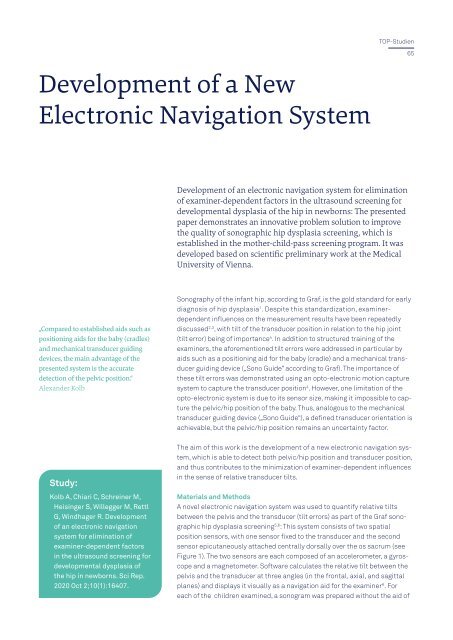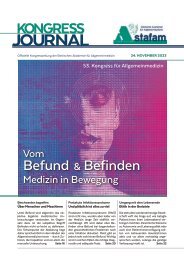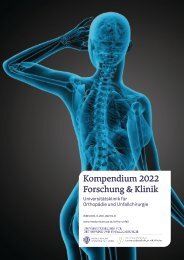Kompendium 2020 Forschung & Klinik
Das Kompendium 2020 der Universitätsklinik für Orthopädie und Unfallchirurgie von MedUni Wien und AKH Wien (o. Univ.-Prof. R. Windhager) stellt einen umfassenden Überblick über die medizinsichen Leistungen und auch die umfangreichen Forschungsfelder dar. Die Veröffentlichungen zeigen die klinische Relevanz und innovative Ansätze der einzelnen Forschungsrichtungen. Herausgeber: Universitätsklinik für Orthopädie und Unfallchirurgie MedUni Wien und AKH Wien Prof. Dr. R. Windhager ISBN 978-3-200-07715-7
Das Kompendium 2020 der Universitätsklinik für Orthopädie und Unfallchirurgie von MedUni Wien und AKH Wien (o. Univ.-Prof. R. Windhager) stellt einen umfassenden Überblick über die medizinsichen Leistungen und auch die umfangreichen Forschungsfelder dar. Die Veröffentlichungen zeigen die klinische Relevanz und innovative Ansätze der einzelnen Forschungsrichtungen.
Herausgeber: Universitätsklinik für Orthopädie und Unfallchirurgie
MedUni Wien und AKH Wien
Prof. Dr. R. Windhager
ISBN 978-3-200-07715-7
You also want an ePaper? Increase the reach of your titles
YUMPU automatically turns print PDFs into web optimized ePapers that Google loves.
TOP-Studien<br />
65<br />
Development of a New<br />
Electronic Navigation System<br />
Development of an electronic navigation system for elimination<br />
of examiner-dependent factors in the ultrasound screening for<br />
developmental dysplasia of the hip in newborns: The presented<br />
paper demonstrates an innovative problem solution to improve<br />
the quality of sonographic hip dysplasia screening, which is<br />
established in the mother-child-pass screening program. It was<br />
developed based on scientific preliminary work at the Medical<br />
University of Vienna.<br />
„Compared to established aids such as<br />
positioning aids for the baby (cradles)<br />
and mechanical transducer guiding<br />
devices, the main advantage of the<br />
presented system is the accurate<br />
detection of the pelvic position.“<br />
Alexander Kolb<br />
Sonography of the infant hip, according to Graf, is the gold standard for early<br />
diagnosis of hip dysplasia 1 . Despite this standardization, examinerdependent<br />
influences on the measurement results have been repeatedly<br />
discussed 2,3 , with tilt of the transducer position in relation to the hip joint<br />
(tilt error) being of importance 4 . In addition to structured training of the<br />
examiners, the aforementioned tilt errors were addressed in particular by<br />
aids such as a positioning aid for the baby (cradle) and a mechanical transducer<br />
guiding device („Sono Guide“ according to Graf). The importance of<br />
these tilt errors was demonstrated using an opto-electronic motion capture<br />
system to capture the transducer position 4 . However, one limitation of the<br />
opto-electronic system is due to its sensor size, making it impossible to capture<br />
the pelvic/hip position of the baby. Thus, analogous to the mechanical<br />
transducer guiding device („Sono Guide“), a defined transducer orientation is<br />
achievable, but the pelvic/hip position remains an uncertainty factor.<br />
Study:<br />
Kolb A, Chiari C, Schreiner M,<br />
Heisinger S, Willegger M, Rettl<br />
G, Windhager R. Development<br />
of an electronic navigation<br />
system for elimination of<br />
examiner-dependent factors<br />
in the ultrasound screening for<br />
developmental dysplasia of<br />
the hip in newborns. Sci Rep.<br />
<strong>2020</strong> Oct 2;10(1):16407.<br />
The aim of this work is the development of a new electronic navigation system,<br />
which is able to detect both pelvic/hip position and transducer position,<br />
and thus contributes to the minimization of examiner-dependent influences<br />
in the sense of relative transducer tilts.<br />
Materials and Methods<br />
A novel electronic navigation system was used to quantify relative tilts<br />
between the pelvis and the transducer (tilt errors) as part of the Graf sonographic<br />
hip dysplasia screening 5,6 : This system consists of two spatial<br />
position sensors, with one sensor fixed to the transducer and the second<br />
sensor epicutaneously attached centrally dorsally over the os sacrum (see<br />
Figure 1). The two sensors are each composed of an accelerometer, a gyroscope<br />
and a magnetometer. Software calculates the relative tilt between the<br />
pelvis and the transducer at three angles (in the frontal, axial, and sagittal<br />
planes) and displays it visually as a navigation aid for the examiner 6 . For<br />
each of the children examined, a sonogram was prepared without the aid of
















